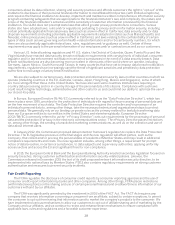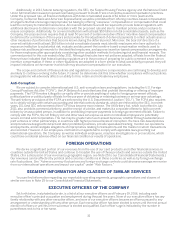American Express 2015 Annual Report Download - page 34
Download and view the complete annual report
Please find page 34 of the 2015 American Express annual report below. You can navigate through the pages in the report by either clicking on the pages listed below, or by using the keyword search tool below to find specific information within the annual report.
The Federal Reserve is expected to publish the decisions for all the bank holding companies participating in CCAR
2016, including the reasons for any objection to capital plans, by June 30, 2016. In addition, the Federal Reserve will
separately publish the results of its supervisory stress test under both the supervisory severely adverse and adverse
scenarios. The information to be released will include, among other things, the Federal Reserve’s projection of
company-specific information, including post-stress capital ratios and the minimum value of these ratios over the
planning horizon.
Dividends
The Company and TRS, as well as Centurion Bank and American Express Bank, are limited in their ability to pay
dividends by banking statutes, regulations and supervisory policy. In general, federal and applicable state banking laws
prohibit, without first obtaining regulatory approval, insured depository institutions, such as Centurion Bank and
American Express Bank, from making dividend distributions if such distributions are not paid out of available recent
earnings or would cause the institution to fail to meet capital adequacy standards. As described in “Prompt Corrective
Action,” the Federal Deposit Insurance Act (“FDIA”) also generally prohibits an FDIC-insured depository institution
from making any capital distribution (including payment of dividends) or paying any management fee to its holding
company if the depository institution would thereafter be undercapitalized. In addition to specific limitations on the
dividends that subsidiary banks can pay to their holding companies, federal banking regulators have authority to
prohibit or limit the payment of a dividend if, in the banking regulator’s opinion, payment of a dividend would constitute
an unsafe or unsound practice in light of the financial condition of the banking organization.
Dividend payments by the Company and TRS to shareholders are subject to the oversight of the Federal Reserve.
It is Federal Reserve policy that bank holding companies generally should pay dividends on common stock only out of
net income available to common shareholders generated over the past year and only if prospective earnings retention
is consistent with the organization’s current and expected future capital needs, asset quality and overall financial
condition. See also “Heightened Prudential Requirements for Large Bank Holding Companies — Capital Planning.”
Moreover, bank holding companies should not maintain dividend levels that place undue pressure on the capital of
depository institution subsidiaries or that may undermine the bank holding company’s ability to be a source of
strength to its banking subsidiaries. The Federal Reserve could prohibit a dividend by the Company or TRS that the
Federal Reserve believes would constitute an unsafe or unsound practice in light of the financial condition of the
banking organization.
In addition, the Company generally is required to obtain prior approval from the Federal Reserve before it can
make capital distributions, including dividend payments, under any of the following circumstances (regardless of
whether the distribution is part of a capital plan to which the Federal Reserve has not objected):
• The Company will not meet a minimum regulatory capital ratio after giving effect to the capital distribution;
• The Federal Reserve has notified the Company that it has determined that either (i) the capital distribution will
result in a material adverse change to the Company’s capital or liquidity structure, or (ii) the Company’s
earnings are materially underperforming projections;
• The dollar amount of the capital distribution will exceed the projected distribution described in the Company’s
approved capital plan; or
• The capital distribution will occur after the occurrence of an event requiring the resubmission (other than
pursuant to an objection) of the Company’s capital plan and before the Federal Reserve has acted on the
resubmitted plan.
Resolution Planning
In December 2015, we filed an updated plan for the rapid and orderly resolution of the Company under the
Bankruptcy Code in the event of material distress or failure. Under rules adopted by the Federal Reserve and the FDIC
pursuant to Dodd-Frank, we are required to update this resolution plan annually and may be required to update it upon
the occurrence of material changes in our business, structure or operations. This resolution planning requirement
may, as a practical matter, present additional constraints on our structure, operations and business strategy, and on
transactions and business arrangements between our bank and non-bank subsidiaries, because we must consider the
impact of these matters on our ability to prepare and submit a resolution plan that demonstrates that we may be
resolved under the Bankruptcy Code in a rapid and orderly manner. If the Federal Reserve and the FDIC determine that
our plan is not credible and we fail to cure the deficiencies, we may be subject to more stringent capital, leverage or
liquidity requirements, or restrictions on our growth, activities or operations, or may ultimately be required to divest
certain assets or operations to facilitate an orderly resolution.
Capital Adequacy
The Company, Centurion Bank and American Express Bank are required to comply with the applicable capital
adequacy rules established by federal banking regulators. These rules are intended to ensure that bank holding
companies and banks (collectively, “banking organizations”) have adequate capital given the level of assets and off-
balance sheet obligations, and to minimize disincentives for holding liquid assets.
23
























